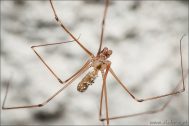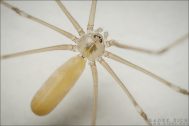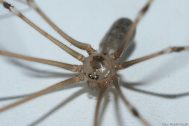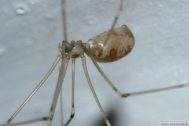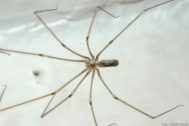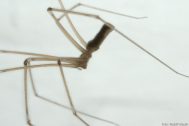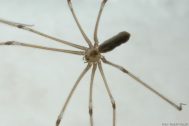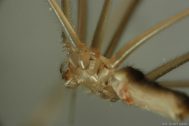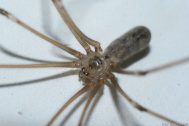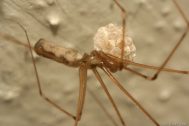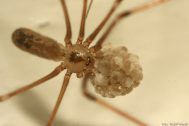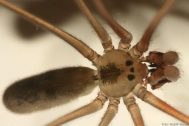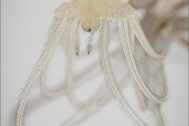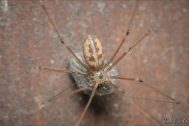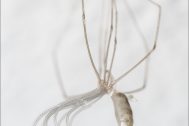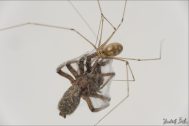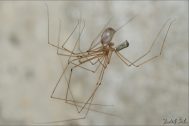| Nálezy podle období | |||||
|---|---|---|---|---|---|
| Pholcidae | 0-1900 | 1901-1950 | 1951-2000 | 2001+ | ∑ |
| Pholcus phalangioides (Fuesslin, 1775) Není ohrožený | 14× | 148× | 162× | ||
Pholcus phalangioides (Fuesslin, 1775)
| České jméno | třesavka velká |
|---|---|
| Stupeň ohrožení | Není ohrožený |
| Nálezy | 163 nálezů, 90 kvadrátů |
| První nález |
1959, J. Buchar, Buchar 1962a |
| Poslední nález | 2025 , Kryštof Rückl |
| Areál rozšíření | Cosmopolitan |
| Fytogeografická oblast | - |
| Původnost stanovišť |
|
| Vlhkost stanovišť | - |
| Stratum |
|
| Osvětlení stanovišť | - |
| Hojnost výskytu |
|
| Nadm. výška | 150-1100 |
Literatura
Karyotype differentiation and male meiosis in European clades of the spider genus Pholcus (Araneae, Pholcidae).
Haplogyne araneomorphs are a diverse spider clade. Their karyotypes are usually predominated by biarmed (i.e., metacentric and submetacentric) chromosomes and have a specific sex chromosome system, X1X2Y. These features are probably ancestral for haplogynes. Nucleolus organizer regions (NORs) spread frequently from autosomes to sex chromosomes in these spiders. This study focuses on pholcids (Pholcidae), a highly diverse haplogyne family. Despite considerable recent progress in pholcid cytogenetics, knowledge on many clades remains insufficient including the most species-rich pholcid genus, Pholcus Walckenaer, 1805. To characterize the karyotype differentiation of Pholcus in Europe, we compared karyotypes, sex chromosomes, NORs, and male meiosis of seven species [Pholcus alticeps Spassky, 1932; P. creticus Senglet, 1971; P. dentatus Wunderlich, 1995; P. fuerteventurensis Wunderlich, 1992; Pholcus phalangioides (Fuesslin, 1775); Pholcus opilionoides (Schrank, 1781); P. silvai Wunderlich, 1995] representing the dominant species groups in this region. The species studied show several features ancestral for Pholcus, namely the 2n♂ = 25, the X1X2Y system, and a karyotype predominated by biarmed chromosomes. Most taxa have a large acrocentric NOR-bearing pair, which evolved from a biarmed pair by a pericentric inversion. In some lineages, the acrocentric pair reverted to biarmed. Closely related species often differ in the morphology of some chromosome pairs, probably resulting from pericentric inversions and/or translocations. Such rearrangements have been implicated in the formation of reproductive barriers. While the X1 and Y chromosomes retain their ancestral metacentric morphology, the X2 chromosome shows a derived (acrocentric or subtelocentric) morphology. Pairing of this element is usually modified during male meiosis. NOR patterns are very diverse. The ancestral karyotype of Pholcus contained five or six terminal NORs including three X chromosome-linked loci. The number of NORs has been frequently reduced during evolution. In the Macaronesian clade, there is only a single NOR-bearing pair. Sex chromosome-linked NORs are lost in Madeiran species and in P. creticus. Our study revealed two cytotypes in the synanthropic species Pholcus phalangioides (Madeiran and Czech), which differ by their NOR pattern and chromosome morphology. In the Czech cytotype, the large acrocentric pair was transformed into a biarmed pair by pericentric inversion.
Pavouci (Araneae) a mnohonožky (Diplopoda) obce Žleby v okrese Kutná Hora.
In 1999–2019, spiders and millipedes in Žleby, a municipality in the District of Kutná Hora were recorded. At 22 sites, the author collected or photographed 854 spider and 642 millipede specimens belonging to 121 spider and 29 millipede species. Most of them are common, however, spiders Ero aphana, Nematogmus sanguinolentus, Silometopus elegans and Amaurobius jugorum, and millipedes Cylindroiulus arborum and Haploporatia eremita, are ecologically significant. The most (millipede) species rich site at Žleby were the left bank of the Doubrava River and the lime alley. During the long-termed survey on spiders, the first occurrence of five recently spreading species (Pholcus phalangioides, Ebrechtella tricuspidata, Argiope bruennichi, Steatoda triangulosa and Ero aphana) was documented at Žleby.Pavouk 43 (12/2017)
Pavouci České republiky; Velké dobrodružství: Physocyclus globosus (Taczanowski, 1874) zavlečen do Evropy; Revize třesavek Pholcus phalangioides v Národním muzeu; Pavouci v hledáčku šotoušů* – Holocnemus pluchei na „hlaváku“; Slíďák tatarský (Lycosa singoriensis) na Šumavě!; Zajímavý nález dvou druhů rodu Acantholycosa na jedné mýtině; Do třetice Araneus saevus, aneb jak je to s historicky druhým nálezem křižáka stromového u nás; Pardosa maisa – slíďák slaništní?; Rodinná dovolená v Beskydech; Spojení arachnologie a kultury; Významné nálezy pavouků z ČR III./ Remarkable records of spiders from Czech Republic III.; Hrabalky (Pompilidae) rodu Anoplius – specialisté na lov pavouků; Překvapení pod mikroskopem; 30th European Congress of Arachnology; 115. arachnologický seminář Brno 2017; Šplh po vlákně; Arachnologický spravodaj; Česká bibliografie 2017; Britská bibliografie – The Newsletter 139; Pokyny pro autoryFotografie
Statistiky
Dle měsíce v roce
Dle nadmořské výšky
Dle metody sběru (160 použitých nálezů)
| Pholcus phalangioides (Fuesslin, 1775) ES | Samci | Samice | Mláďata | Nálezy |
|---|---|---|---|---|
| Individuální sběr | 89 | 143 | 139 | 65 |
| Pozorování | 21 | 132 | 30 | 57 |
| Neurčeno | 7 | 29 | 12 | 27 |
| Fotografie | 4 | 4 | 1 | 7 |
| Smyk | 1 | 0 | 0 | 1 |
| Zemní past | 3 | 4 | 0 | 3 |
| Samci | Samice | Mláďata | Nálezy |
Dle biotopu (161 použitých nálezů)
| Pholcus phalangioides (Fuesslin, 1775) ES | Samci | Samice | Mláďata | Nálezy |
|---|---|---|---|---|
| Interiéry budov | 93 | 195 | 84 | 84 |
| Vnější stěny budov | 2 | 5 | 0 | 5 |
| Okraje silnic | 1 | 1 | 0 | 1 |
| Neurčeno | 7 | 38 | 13 | 26 |
| Ruderály | 25 | 75 | 85 | 44 |
| Zahrady | 0 | 1 | 0 | 1 |
| Samci | Samice | Mláďata | Nálezy |



